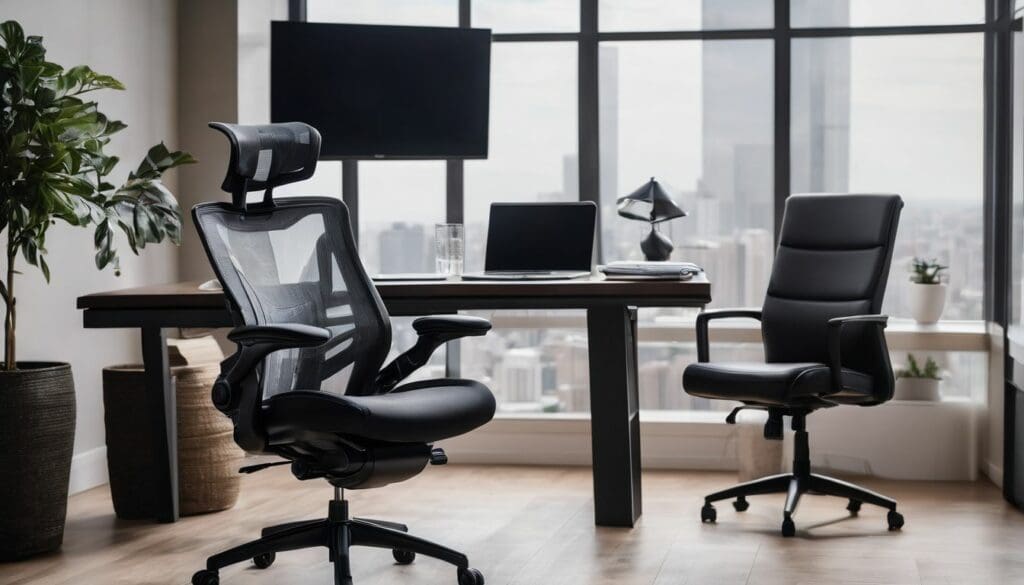You’ve been sitting at your desk all day and now your back is aching. Ergonomics, or the science of work comfort, can help prevent this common complaint. This blog will guide you through simple changes to improve your posture and bring relief.
Let’s make comfort a part of your daily routine!
Key Takeaways
- Ergonomic furniture, like adjustable desks and chairs with proper support, can significantly improve posture and reduce body strain.
- Regular movement breaks throughout the day are vital to avoid stiffness and promote good circulation, enhancing both mental focus and posture.
- Maintaining neutral body posture when sitting or standing is essential for spinal health; use props like cushioned backrests and monitor stands for alignment assistance.
- Supportive footwear helps distribute your weight evenly which is beneficial for spine alignment and overall postural health.
- Creating an ergonomic workstation with sustainable materials supports not only personal well – being but also environmental conservation efforts.
Understanding Posture and Ergonomics
Posture refers to the alignment of your body while sitting, standing, or lying down. Ergonomics involves designing and arranging workspaces to promote good posture and reduce strain on the body.
It’s important to understand how these two factors can impact your overall health and well-being.
What is Posture?
Posture refers to the way you hold your body upright against gravity while sitting, standing, or lying down. Good posture involves training your body to stand, walk, sit and lie in positions where the least strain is placed on supporting muscles and ligaments during movement or weight-bearing activities.
Proper alignment of the body reduces stress on the spine and helps maintain a neutral spine position. It’s crucial for overall health as it minimises back and neck pain by ensuring joints and bones are in correct alignment so that muscles are used correctly.
Having a good sitting posture is particularly important when spending hours at an office desk. It means keeping feet flat on the floor, with knees at hip level and lower back support firmly in place.
Shoulders should be relaxed but not slouched, with arms resting comfortably at your sides. This neutral body stance promotes effective circulation and supports long-term musculoskeletal health which is essential for anyone conscious about their well-being – including those committed to conservation and environmental responsibility because personal health goes hand-in-hand with environmental stewardship.
What is Ergonomics?
Ergonomics involves designing and arranging the environment to fit the people who use it. It aims to enhance efficiency and productivity while reducing discomfort and risk of injury.
Ergonomic adjustments in the workplace can lead to better posture, reduced strain on muscles, and improved overall well-being. By creating an ergonomic workspace with proper body alignment and supportive furniture, individuals can alleviate back and neck pain, support their muscles, and engage their shoulders and back effectively.
This approach not only enhances physical comfort but also contributes to a more environmentally conscious lifestyle by promoting sustainable work practices in line with conservation efforts.
Why Does Posture Matter?
Proper posture is crucial for maintaining a healthy spine and reducing the risk of back and neck pain. It also supports optimal breathing, digestion, and circulation. Good posture helps in strengthening and engaging the supportive muscles of the shoulders and back, preventing strain and discomfort.
Additionally, correct sitting posture contributes to better alignment of the body’s structure, enhancing overall well-being while decreasing reliance on pain relief medications.
Engaging core muscles through proper sitting posture not only improves physical comfort but also increases mental alertness while promoting environmental consciousness by encouraging active engagement with your surroundings, supporting conservation efforts through movement breaks, improving efficiency in daily activities whilst conserving energy consumption.
Common Signs of Poor Posture
Poor posture can lead to a range of physical symptoms including forward head tilt, slouched shoulders, and persistent discomfort in the back, neck or shoulders. These signs indicate misalignment and strain on the body’s muscles and joints.
Forward Head Tilt
Poor posture, particularly a forward head tilt, can cause strain on the neck and upper back. This position is often seen in individuals who spend long hours hunched over a computer or desk.
The muscles at the back of the neck become overstretched, leading to discomfort and stiffness. To combat this, it’s important to be mindful of keeping the head aligned with the shoulders when sitting or standing.
Gentle neck stretches and regular breaks to release tension in the neck and upper back can help alleviate these issues.
Slouched Shoulders
Slouched shoulders are a common sign of poor posture, often resulting from prolonged sitting or standing with rounded shoulders. Slouching can lead to strain on the neck and upper back muscles, causing discomfort and reducing overall productivity.
To combat this, incorporate regular shoulder rolls and stretches into your daily routine to improve posture and reduce tension in the upper body.
Engage your shoulder and back muscles by consciously pulling your shoulders back while sitting or standing, promoting a more aligned spine. If possible, adjust your workstation to encourage good posture – consider ergonomic chairs that provide proper support for your lower back.
By prioritising postural awareness in everyday settings like workstations, you can alleviate slouched shoulders and promote better overall posture.
Hunched Upper Back
Transitioning from addressing slouched shoulders to hunched upper back, it’s essential to recognise the impact of prolonged sitting or standing with rounded shoulders and a forward head position.
Hunching over may lead to increased strain on the upper back muscles and spinal discs, potentially resulting in discomfort and reduced mobility.
To alleviate pressure on your upper back caused by hunching, it is crucial to incorporate regular movement breaks into your daily routine. Engaging in simple stretching exercises, shoulder blade squeezes, and gentle chest-opening movements can help counteract the effects of a hunched upper back.
Uneven Hip Alignment
Transitioning from addressing the issue of a hunched upper back, another common sign of poor posture is uneven hip alignment. This misalignment can result from prolonged sitting and can lead to discomfort and pain in the lower back, hips, and legs.
It can also affect our gait and overall mobility.
Regular movement breaks, ergonomic furniture that supports natural body alignment, and targeted exercises to strengthen core muscles are key elements in preventing and addressing uneven hip alignment.
Persistent Discomfort in Back, Neck or Shoulders
Persistent discomfort in the back, neck, or shoulders indicates poor posture and ergonomic issues. It can lead to long-term pain and discomfort, impacting productivity and overall well-being.
Addressing these symptoms with simple ergonomic adjustments and regular movement breaks can alleviate the strain on your body.
Improving posture and ergonomics through conscientious workstation setups, supportive furniture, and maintaining neutral body posture is crucial for reducing persistent discomfort in the back, neck or shoulders.
How Your Workstation Affects Your Posture
Your workstation plays a crucial role in your posture. The type of furniture, screen ergonomics, and work stress can all impact how you sit and move throughout the day. Understanding these factors is essential for maintaining good posture and reducing discomfort.
Importance of Ergonomic Furniture
Ergonomic furniture is crucial for maintaining good posture and reducing the risk of back and neck pain. It promotes a neutral body position, supporting the natural curvature of the spine and minimising strain on muscles.
By using adjustable chairs, standing desks, and supportive accessories, you can create a comfortable workstation that encourages proper alignment and movement throughout the day.
Investing in ergonomic furniture not only enhances your work environment but also contributes to sustainability. Durable, high-quality ergonomic pieces are designed for longevity, reducing waste from frequent replacements.
Maintaining Neutral Body Posture
Maintaining neutral body posture is crucial for reducing strain on your muscles and joints. Here are some simple adjustments you can make to maintain a neutral body posture:
- Sit with feet flat on the floor and knees at a 90-degree angle.
- Keep your back straight and supported by the chair’s backrest.
- Adjust the height of your chair so that your arms are parallel to the ground when typing.
- Ensure that your computer screen is at eye level to avoid straining your neck.
- Use a supportive chair cushion to maintain proper spinal alignment.
Proper Lifting Techniques
- Engage your core muscles before lifting any object to provide stability and support to your spine.
- Bend at your knees and not at your waist when lifting heavy objects to distribute the weight evenly and reduce strain on your back.
- Lift with a straight back, avoiding twisting movements that can cause injury.
- Hold the item close to your body whilst lifting to minimise the strain on your back and shoulders.
- Avoid sudden jerking movements when lifting; instead, lift smoothly and steadily.
Optimising Screen Ergonomics
To optimise screen ergonomics, position your monitor at arm’s length and at eye level to reduce strain on your neck and eyes. Adjust the brightness and contrast of your screen to prevent eye fatigue, and use a blue light filter to minimise exposure to harmful blue light. Ensure that your keyboard and mouse are placed at a comfortable distance to avoid reaching or straining. In addition, take regular breaks to rest your eyes and stretch your body, practicing the 20-20-20 rule by looking at something 20 feet away for 20 seconds every 20 minutes. Finally, consider using ergonomic accessories such as an adjustable monitor stand or an ergonomic keyboard and mouse to further enhance your workstation setup.
Managing Work Stress
To optimise screen ergonomics can help reduce physical strain, but managing work stress is equally important for overall well-being. Environmental advocates may find it beneficial to incorporate stress management techniques into their daily routines.
Taking regular movement breaks, practising mindfulness, and maintaining a healthy work-life balance are crucial in minimising workplace stress.
Creating a calming workspace with green plants or natural light can also contribute to reducing stress levels. It’s essential to prioritise mental well-being alongside ergonomic adjustments for a holistic approach to promoting health and sustainability in the workplace.
Tips for Improving Posture and Ergonomics
– Incorporate regular movement breaks into your workday to avoid prolonged periods of sitting and slouching.
– Invest in supportive footwear that promotes good posture and provides comfort for extended periods of standing or walking.
Take Regular Movement Breaks
Integrate short breaks into your workday to alleviate the strain on your muscles and improve circulation. Setting a timer every hour as a reminder for a quick walk or stretch can prevent stiffness and reduce the risk of developing musculoskeletal issues from prolonged sitting.
Regular movement breaks also stimulate mental focus, creativity, and productivity. Engage in simple desk exercises such as shoulder rolls, neck stretches, or standing up for a few minutes to maintain energy levels throughout the day.
Remember that small intervals of physical activity make a significant impact on both posture improvement and overall well-being.
Use Supportive Footwear
Choose footwear that provides proper arch support and cushioning. This will help distribute your body weight evenly, reducing strain on your back, knees, and hips. Supportive footwear can also improve your posture by promoting a more natural alignment of the spine and pelvis.
Look for shoes with a wider toe box to allow for natural foot movement, preventing discomfort and potential posture problems. Additionally, consider incorporating orthotic insoles if you need extra support or have specific foot conditions.
Investing in supportive footwear can make a significant difference in how you feel throughout the day. By prioritising the comfort and alignment of your feet, you can positively impact your overall posture and reduce the risk of developing musculoskeletal issues related to poor ergonomics at work or home.
Create an Ergonomic Workstation
- Use a height – adjustable desk made from sustainable materials, such as bamboo or reclaimed wood, to reduce strain on your back and neck while sitting or standing.
- Invest in a comfortable, ergonomic chair made from recycled materials with adjustable lumbar support and armrests to promote healthy sitting posture.
- Position your computer monitor at eye level to alleviate strain on your neck and eyes, using energy-efficient LED monitors to reduce environmental impact.
- Utilise natural light by positioning your workstation near a window or use energy – saving task lighting to reduce reliance on artificial lighting.
- Incorporate eco-friendly desk accessories like cork or bamboo-based mouse pads and keyboard wrist rests to support sustainable practices within your workspace.
- Integrate indoor plants into your workstation to enhance air quality and foster a more natural and calming environment.
Use Posture-Friendly Props & Furniture
Choose posture-friendly props and furniture to support your body’s natural alignment. Opt for an ergonomic chair with good lumbar support and adjustable height. Consider using a standing desk or a convertible desk attachment for alternating between sitting and standing positions.
Utilise a seat cushion or backrest to maintain proper spinal curvature, reducing strain on your lower back.
Incorporate equipment like monitor stands, keyboard trays, and footrests to achieve an ergonomic workstation setup. When selecting these items, prioritise sustainable materials and products that align with eco-friendly values.
Prioritise Posture in Everyday Settings
When sitting, ensure your feet are flat on the floor and your knees are level with your hips. Sit back in your chair, using a small cushion to support the natural curve of your lower back.
Keep your shoulders relaxed and avoid slouching or leaning to one side. Whether standing or walking, maintain a neutral spine by keeping your head aligned with your neck and shoulders.
Engage your core muscles and distribute weight evenly between both feet to promote good posture throughout the day.
Choose an ergonomic backpack or bag that distributes weight evenly across both shoulders. When using electronic devices, hold them at eye level to prevent strain on the neck and upper back.
Conclusion
Incorporate small changes for better posture by adjusting your workstation. Engage in regular movement breaks to reduce strain on your body. Prioritise posture-friendly props and furniture to support good posture at work and in everyday settings.
Use supportive footwear, maintain neutral body posture, and optimise screen ergonomics for a healthier spine.
FAQs
1. What are simple ergonomic adjustments I can make for better posture at work?
You can adjust your office desk setup to support good posture by making sure your monitor is at eye level and your chair supports the curve of your back.
2. How can I relieve back and neck pain while working?
To find relief from back and neck pain, take short breaks to do desk exercises aimed at posture improvement, such as shoulder rolls and stretches that engage your back.
3. Can changing my workplace ergonomics really improve my posture?
Yes, applying workplace ergonomics principles like adjusting the height of your chair and using a footrest can greatly enhance shoulder and back engagement for improved office posture.
4. Why is it important to have proper work ergonomics in the office?
Maintaining proper work ergonomics helps prevent strain on your body, reducing risks of discomfort or injury related to poor desk setups so you stay healthy while working.





